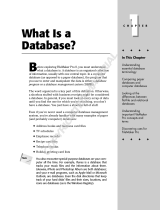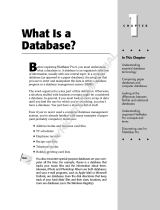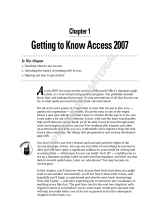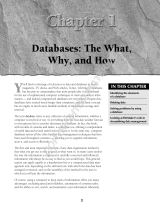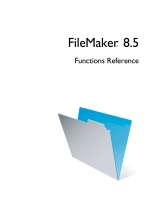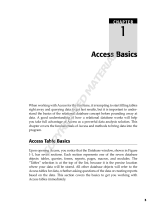
FileMaker Pro overview | 17
Creating scripts to automate tasks
Scripts can do simple tasks like setting print orientation or complex tasks like
preparing a customized mailing to clients.
For example, you could define a script that creates a thank you letter to clients
in your database who have made a purchase in the last week. The script
composes a letter customized to each client. The script then switches to
Preview mode and pauses so that you can see what the letter looks like before
it prints. The whole task is started by clicking a button on a layout.
You use the Manage Scripts (formerly ScriptMaker) feature in FileMaker Pro
to build scripts by selecting from a list of FileMaker
Pro script steps, specifying
options, and arranging the steps in the correct order to perform the task.
FileMaker
Pro makes it easy to manage and maintain scripts, even for complex
databases. You can simultaneously view, edit, and manage scripts from
different databases. For more information about scripts, see
“Automating tasks
with scripts” on page 68.
Sharing and exchanging data
A benefit of storing data in FileMaker Pro is sharing your data with others. You
can share your data with other FileMaker
Pro users on a network, use the web
publishing capabilities to share data over the web, or import or export data
from another file. In addition, you can use ODBC (Open Database
Connectivity) and JDBC (Java Database Connectivity) to share FileMaker
Pro
files with ODBC- and JDBC-compliant applications, or you can access data
from external data sources.
If your computer is connected to a network, you and other Windows and
Mac OS FileMaker Pro users can use the same FileMaker Pro database file
simultaneously. FileMaker
Pro Network Sharing supports the sharing of files
with up to nine concurrent users.
Note If you need to share files with more than nine concurrent users on a network,
FileMaker recommends the use of FileMaker Server.
You can quickly and easily publish FileMaker Pro layouts as web pages, which
allows anyone with a web browser on your intranet (or the internet) to access
your FileMaker
Pro databases.
φμπ10_υσερσ_γυιδε.βοοκ Παγε 17 Μονδαψ, Αυγυστ 25, 2008 3:59 ΠΜ




















